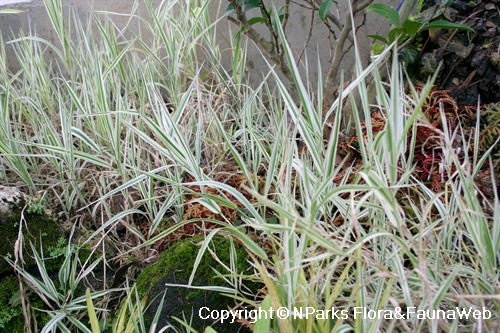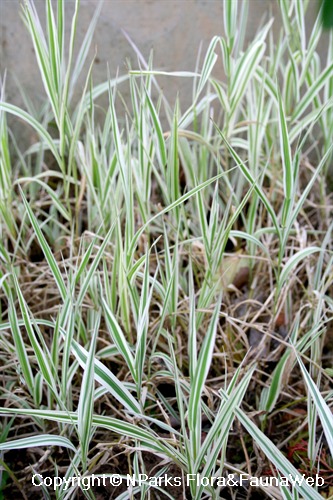
Back
Arrhenatherum elatius subsp. bulbosum 'Variegatum'
| Family Name: | Poaceae (Gramineae) |
| Synonyms: | Arrhenatherum elatius var. tuberosum 'Variegatum', Avena bulbosa 'Variegatum', Arrhenatherum avenaceum var. bulbosum 'Variegatum' |
| Common Name: | Striped Tuber Oat Grass, Variegated Tall Oatgrass, Variegated Bulbous Oat Grass, False Oat Grass, Orchard Grass |
Name
Classifications and Characteristics
| Plant Division | Angiosperms (Flowering Seed Plants) (Monocotyledon) |
|---|---|
| Plant Growth Form | Grass or Grass-like Plant |
| Lifespan (in Singapore) | Perennial |
| Mode of Nutrition | Autotrophic |
| Plant Shape | Shrubby |
| Maximum Height | 0.3 m to 0.5 m |
Biogeography
| Native Distribution | Northern Africa, southwestern Europe (France, Portugal, Spain) |
|---|---|
| Native Habitat | Terrestrial (Grassland / Savannah/ Scrubland) |
| Preferred Climate Zone | Sub-Tropical / Monsoonal, Mediterranean |
Description and Ethnobotany
| Growth Form | Perennial clump-forming grass, up to 50cm tall. |
|---|---|
| Foliage | Leaf blades narrowly linear, with green longitudinal stripes and white margins, soft to the touch, arising from basal or underground stacks of bulbous storage corms. |
| Flowers | Panicles of inconspicuous greenish to purplish flowers. Not produced under hot dry conditions. |
| Cultivation | Relatively slow-growing cool-season grass, likes dry days and cool nights. Prefers fertile, moist well-drained soils. Requires regular watering, especially during hot weather, which can cause leaf-tip browning and the foliage to die down. For neater look, browned trips can be sheared off, and old dead foliage can be removed for new regrowth. Propagate by division (clump can be divided once every 2-3 years), or root cuttings. |
| Etymology | Genus epithet 'Arrhenatherum' derived from Greek terms 'arren' (male) and 'anther' (bristle), referring to the bristly awns on the male flowers. Species epithet 'elatius' means 'tall', alluding to the foliage; while subspecies epithet 'bulbosum' means 'bulbous', describing the swollen corms at the base of the plant.Despite its common names, plant is not related to the true Oats (Avena genus). Father of modern taxonomy Linnaeus mistakenly classified this group of grasses under Avena, but while the botanical name has been corrected, the association remained in the common names. |
Landscaping Features
| Desirable Plant Features | Ornamental Foliage |
|---|---|
| Landscape Uses | General, Flowerbed / Border, Container Planting |
| Thematic Landscaping | Rockery / Desert Garden, Naturalistic Garden, Wildflower Garden |
Fauna, Pollination and Dispersal
| Pollination Method(s) | Abiotic (Wind) |
|---|
Plant Care and Propagation
| Light Preference | Full Sun, Semi-Shade |
|---|---|
| Water Preference | Moderate Water |
| Plant Growth Rate | Slow |
| Rootzone Tolerance | Well-Drained Soils |
| Propagation Method | Seed, Root Cutting, Storage Organ, Division |
| Maintenance Requirements Remarks | Leaves may turn brown and die down with hot weather, causing plant to look unkempt. |
Foliar
| Foliage Retention | Drought / Semi-Deciduous |
|---|---|
| Mature Foliage Colour(s) | Cream / Off-White, Green, White |
| Mature Foliage Texture(s) | Smooth, Thin |
| Foliar Type | Simple / Unifoliate |
| Foliar Shape(s) | Non-Palm Foliage (Linear) |
| Foliar Venation | Parallel |
| Foliar Margin | Entire |
| Foliar Apex - Tip | Acuminate |
| Typical Foliar Area | Notophyll ( 20.25cm2 - 45 cm2 ) |
| Leaf Area Index (LAI) for Green Plot Ratio | 3.5 (Shrub & Groundcover - Monocot) |
Non - Foliar and Storage
| Stem Type & Modification | Acaulescent |
|---|---|
| Root Type | Underground (Fibrous Root) |
| Specialised Storage Organ(s) | Underground (Corm) |
Floral (Angiosperm)
| Flower & Plant Sexuality | Unisexual Flowers , Monoecious |
| Flower Colour(s) | Cream / Off-White, Green, Purple |
|---|
| Inflorescence Type | Panicle |
| Flowering Habit | Polycarpic |
Image Repository
Others
| Master ID | 29116 |
|---|---|
| Species ID | 3427 |
| Flora Disclaimer | The information in this website has been compiled from reliable sources, such as reference works on medicinal plants. It is not a substitute for medical advice or treatment and NParks does not purport to provide any medical advice. Readers should always consult his/her physician before using or consuming a plant for medicinal purposes. |

